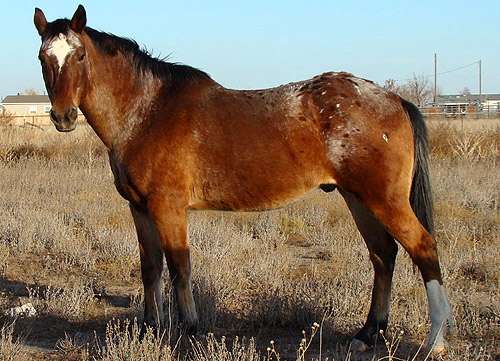Although in many ways they symbolize the horses of America, appaloosas are thought to have come to the Americas via the Spanish. Their ancestors dating back thousands of years in Asia and Europe.
Quickly Adopted
The people Native to American soil prized the spotted horses and different tribes began breeding of both the appaloosas and the pinto horses. Like the pintos, there is a wide variety of coloration found. Almost all breeds carry the appaloosa white pattern genes, so they are found in many shapes and colors.
Here I’ve put together as many of the combinations as I could find, to give a clear example of the prolific nature of the appaloosa white pattern genetics.
Base Colors
There are two basic colors of horses, black and chestnut. All color modifications, dilutions and white pattern displays come from variations of these two basics.

Appaloosa white pattern on a black base.

Appaloosa white pattern on a chestnut base.
Modifiers
Color modifiers affect the two bases in a number of ways. Each of different modifier can also be acted upon by white patterns.

Appaloosa white pattern on a bay horse.

Appaloosa white pattern and a flaxen modifier on a chestnut base.

Comes from an appaloosa white pattern and a mealy modifier (this example is a bay base).
Dilutions
The dilution genes can affect base colors and modified colors, creating many of the flashier colors. White patterns can have an effect, which renders some of the rarer appaloosa colors.

The result of an appaloosa white pattern and a creme dilution gene on a chestnut base.

Comes from an appaloosa white pattern and a dun dilution gene on a chestnut base.
White Patterns
Horses can also display the affects of more than one white pattern. As the color spectrum is given more options, the colors tend to become rarer.

This coloration comes from an appaloosa white pattern and a roan white pattern on a black base.

Due to an appaloosa white pattern and a roan white pattern on a bay animal.
There’s More
If you enjoyed the appaloosa rainbow, be sure to check out the rainbow of pintos too.
Hi!
I just wanted to let you know about the mare you have posted that is owned by Design Sporthorses (the red dun) she was DNA coat color tested and is Ee, she is genetically a black based horse, more accurately a grulla, as she carries dun and dun + black is grulla….
By the way your website and photo’s are very nice.
Hi Amy,
Thanks for the information & your compliment.
She is a beautiful mare. I’ll have to amend the post to reflect her actual genetics.
I have recently got a bay mare in March. She was the cutest little bay mare I ever saw. Now that she is shedding out, she seems to have grey or roaning marks on her face, neck, and more so one her chest area. She has very few white spots (they are about the size of a pea, and she has about five total) What pattern is that?
Just thought I would mention that the “black” Appaloosa shown above and taken from my website discussion of color is actually a smokey black….black with a single cream dilution….the reason for the “off black” color he shows.
Hi Dorothy,
Thanks for the clarification, I will have to add him where he belongs. He is beautiful! 🙂
Oh my that blue roan and black appaloosa’s are gorgeous! I would love to have the blue roan those horses are beautiful and absolutly great to ride!
how rare are the buckskin appys i am going to buy a buckskin appy tb cross
Easy to get buckskin Appy’s….find a homozygous Appy and breed to a perlino with EEAACrCr testing….buckskin Appy each time!!
hey iam trying to figure out what my appaloosa is he looks like the pally but ive been told hes a chestnut can you help me out at all
Karley….what color are parents? One of them would have to be a cream dilute for him to be paly. You can test for cream dilute…if he’s “eecrcr” then he’s chestnut…if he’s “eeCrcr” he’s paly.
i have a appaloosa and can figure out what colour he is iam not sure could you help me at all
Thanks for the credits on my stud. lisa estridge, palisadesapps.com
Hi there, the palomino horse photo was taken by me, lisa estridge,
at Palisadesapps.com So the credit is wrong. I’ve seen it used
other places on the internet too.. so my photo has been “borrowed”.